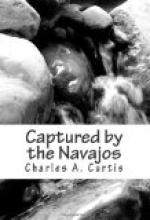After completing the tinting the girls would walk about for a while and display their work to admiring friends, and then plunge into and swim about the lagoon with the ease and grace of a lot of mermaids; emerging with no trace left of their recent ornamentation, they would proceed to renew it in different designs, and take another swim.
“Quite like watering-place belles with extensive wardrobes,” remarked Frank.
“And takes about as long to put on the paint as to put on a fashionable dress,” said Henry, “but not so long to remove it.”
Another thing that amused the boys was a balsa, or raft, made by the Mojaves, of the cane-grass which grew in the river-bottoms to the height of fifteen feet. A large bundle bound at the ends with grass ropes would sustain two men. The boys borrowed one of an Indian girl, who was sitting in the shade of some willows prinking herself artistically with an original and intricate pigmentary pattern. Stepping on board, they paddled about the lagoon for a considerable period.
Tiring at last of the sport, they separated, Frank saying that he was going for his shot-gun, and perhaps shoot for some quail, and Henry that he meant to find Tom Clary and set some lines for catfish.
The younger sergeant failing to find the soldier, selected a line, and, procuring some bait, returned alone to the lagoon. On his way he met the Indian girl walking along the sidewalk, an object of admiration and envy to the men and women of her people. Her bronze flesh was adorned with a lacelike tracery of beautiful design, in many tints.
“How exceedingly pretty!” said Henry, in Spanish, a language fairly well understood by the aborigines of the Southwest.
“I, or my paint?” asked the girl, coquettishly.
“The paint is well put on; but I think you prettiest just after a swim.”
“Thank you, senor.”
“May I use the balsa again, Indita?”
“Si, senor, and you may keep it, but return the paddle.”
“Thank you. I will leave the paddle on the shore where you were sitting.”
With this exchange of civilities Henry walked down to the pool. An idea had occurred to him. He wondered if he could not float down the river to the racing-ground and get a peep at Sancho and Chiquita, as they came in victors. He felt sure no ponies in Arizona could outrun them. But Mr. Duncan had told the escort not to go to the race. True; but what harm could there be if he kept out of sight?
Placing an empty box on the raft for a seat, he took Vic on board, and began paddling out of the lagoon. Speed could not be made with such a craft; it was simply a convenience for crossing or journeying down the river. The Mojaves, whose village was five miles above La Paz, came down on freshly made balsas every day, but walked home, carrying their paddles.
Once well out of the lagoon, and in the river-current, the boy and dog were swept along at a swift rate.




